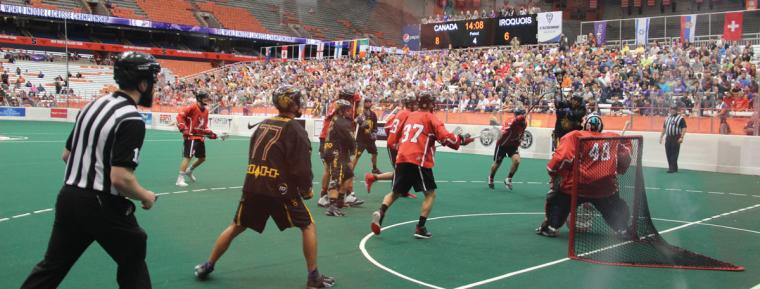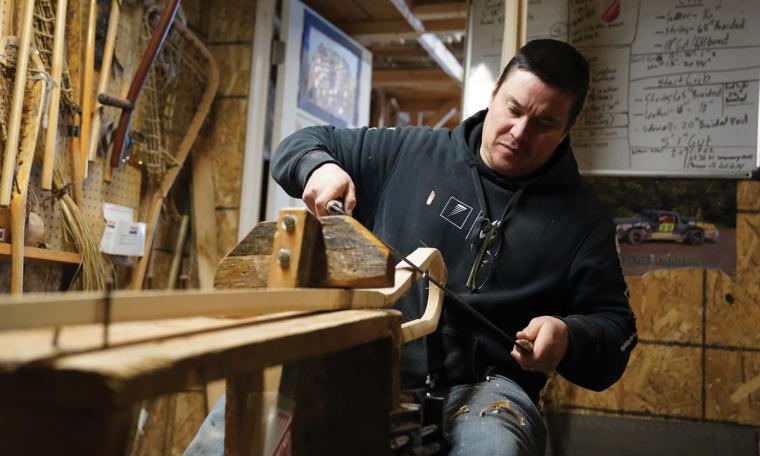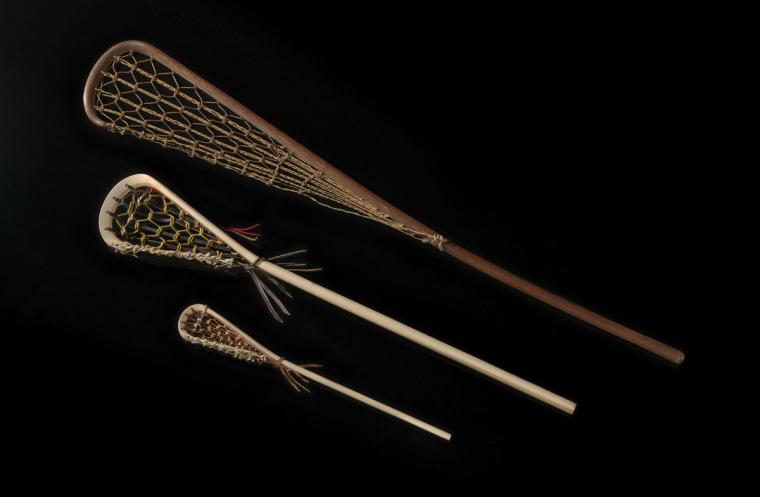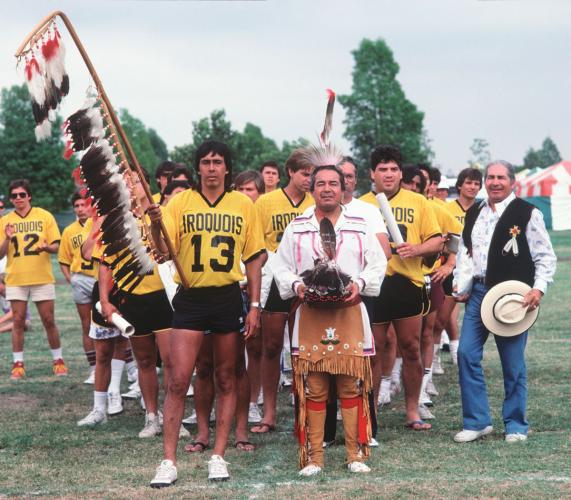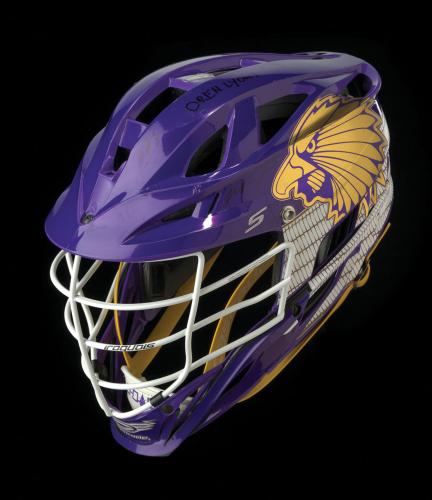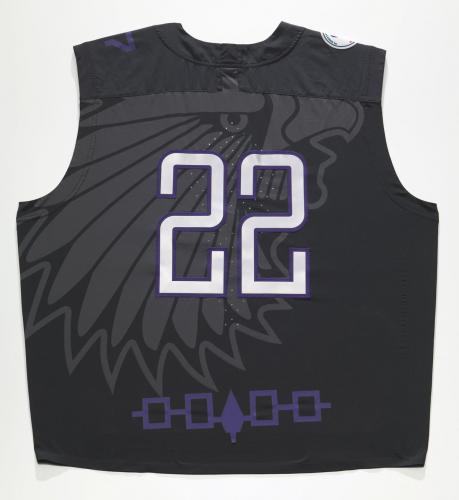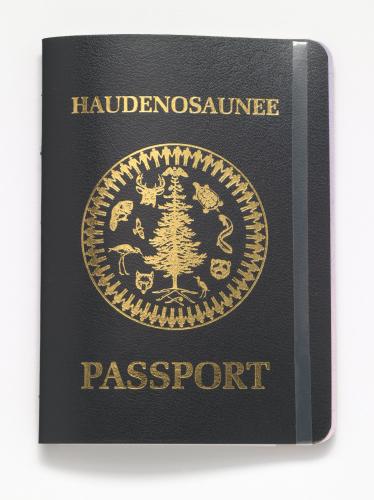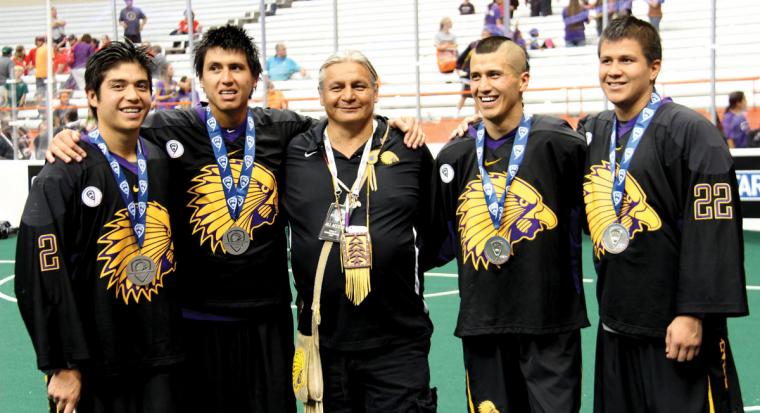Every spring, youth in more than 40 countries are donning helmets and pads while gripping sticks with nets, poised to toss a small rubber ball into a goal. As of 2021, this game—lacrosse—continues to gain traction at an international level. Yet few may realize this team sport is one of the oldest in North America and has deep roots in Native culture. And even though the Haudenosaunee Confederacy (Iroquois) introduced lacrosse to the world and even participated as one of three teams at the 1904 Olympics, more than a century later, the founding culture of this sport is still striving to play it in arenas around the world.
A Healing Gift
The Haudenosaunee believe lacrosse was a gift from the Creator. Some tell the story of Sky Woman, who fell to Earth and landed on the back of a great turtle. Sky Woman rubbed the back of the turtle with soil, which became the Earth or as it known in many Native cultures, Turtle Island.
Sky Woman later had a daughter, Tekawerahkwa or Breath of the Wind, who gave birth to twins. One, Sapling, was good, and the other, Flint, was bad. They always fought, even in the womb. While Sapling’s birth was normal, Flint erupted out of his mother’s armpit, killing her. As the twin’s grandmother, Sky Woman, raised the boys, she decided they should play lacrosse to peacefully resolve their disputes.
Rick Hill (Tuscarora), co-founder of the Haudenosaunee Confederacy’s lacrosse team, the Iroquois Nationals, relayed another story about the sport’s origins: “Some warriors went to the Sky World, the spiritual realm beyond the clouds, and found that a lacrosse game was going on, much to the delight of the spirits on that other side. Because the game was a way for the men to work out their aggression without violence, it became the Creator’s favorite game. When those warriors returned from the Sky World and had learned to give up killing, they introduced the game of lacrosse and we have been playing it ever since.”
Lacrosse continues to be an essential part of Haudenosaunee identity and culture, and Hill says that the game still has the ability to heal. “It is recreation, social, spiritual and metaphysical in that it represents a form of medicine power,” he says. “The power of the stick, the movement of the ball and player conduct contributed to its ability to entertain or to cure.”
Hill says traditionally, “Each family and clan had lacrosse players. They were admired for the natural abilities, fleetness of foot, agility to move past defenders, and the accuracy of their passing and scoring. In the old days, a single pole would serve as the goal and the players had to hit it with a leather or wooden ball. Later, two fork poles were placed in the ground and another pole was placed crosswise for the goal. Old games were played until one team scored three goals.” Today the games are played based on four 12-minute quarters.
Jack Johnson (Akwesasne Mohawk) is a lacrosse stick maker who uses traditional materials such as hickory wood that are harvested locally for the sticks and rawhide gut wall to weave the nets. “Making lacrosse sticks is kind of my medicine,” he says. “It just keeps me happy. I think in creating something, where you harvest and cut the trees, as long as you are in a good mind and you do it the original way, that’s what it is all about.”
Today, traditional sticks are still given to young children, even while they are still in the crib. Youth begin to play the game starting at age seven in pee wee leagues. Some players still use traditional sticks to practice at home. To the Iroquois, an important aspect of the game is remembering the traditional origins of the sport.
Going International
Though Native players brought the sport of lacrosse to the world, they have often been banned from playing it. Beginning in the 1630s, when Jesuits first saw lacrosse being played, they condemned it, saying it was violent and that bets were placed on the sport. In 1740 French colonists began to play but were no match for the Haudenosaunee players.
In the 1840s, non-Native players began to take up the sport. In 1856, William George Beers founded the Montreal Lacrosse Club and created new rules to shorten the game. In the 1860s the sport became Canada’s national game. Then in 1867, the National Lacrosse Association (NLA) of Canada prohibited Indigenous players from joining. In 1880, they were banned from playing in championship games.
Though history has largely omitted their involvement, Iroquois lacrosse players competed at the 1904 Olympic games as did the Winnipeg Shamrocks. The last year the sport was recognized at the Olympics was 1908, when only two teams played, one from Canada and the other from Great Britain. The Iroquois did not play.
However, not until the Iroquois Nationals was formed in 1983 was the team considered a true contender. The Nationals is the only all-Native lacrosse team. Oren Lyons (Onondaga) and Hill co-founded the team to assert Native representation in the sport and Haudenosaunee sovereignty while showing the world that a Native team was deserving of international recognition.
The first years the team played it was defeated by collegiate teams. In 1984, the Iroquois Nationals defeated England at a special tribute game prior to the Los Angeles Olympic games. The following year team members used their Iroquois passports to play in England.
Though the team played at a high level, its climb to participate at the championship levels was at first stifled by the official international governing body of the sport, the Indoor Lacrosse Federation (ILF). In 1986, the Iroquois Nationals’ petition to take part in 1986 World Indoor Lacrosse Championships was denied by the ILF. The reasons for denial are unclear, but many cite the Nationals’ unique position as a team from a sovereign Native nation as a possible reason. However, the following year, the ILF accepted the Nationals as the fifth team from a nation, along with those from Australia, Canada, England and the United States.
As the only Native team in the ILF, they competed in their first international event at the 1990 World Indoor Lacrosse Championships, finishing fifth out of five teams. They would win their first world championship series match in 1994 against Japan with a score of 16–2. The Nationals have since won two bronze medals in 2014 and 2018 at the World Lacrosse Championships. Additionally, the team hosted the 2015 World Indoor Lacrosse Championships at the Onondaga Nation, winning a silver medal.
Though lacrosse was traditionally seen solely as a men’s sport, the formation of the Iroquois Nationals inspired Haudenosaunee women to create the Haudenosaunee Women’s Lacrosse team. The team was officially recognized by the Federation of International Lacrosse (FIL) in 2008. Today, the lacrosse leagues in North America are three men’s leagues—the National Lacrosse League, Major League Lacrosse and Premier Lacrosse League—and two women’s, the Women’s Professional Lacrosse League and United Women’s Lacrosse League.
A Stamp of Sovereignty
In order to participate in the international competitions such as the Olympics, teams must come from nations recognized by the International Olympic Committee. Otherwise, they may never make it into the country where they are supposed to be competing.
The Haudenosaunee Confederacy has issued passports since 1927. These were widely accepted at borders until the terrorist attacks targeting New York and Washington, D.C., on September 11, 2001, increased security measures and restricted border crossings. Some foreign nations have refused to recognize the confederacy as a sovereign entity independent of the United States or Canada, on which six Native nations that belong to the confederacy—the Mohawk, Oneida, Onondaga, Cayuga, Seneca and Tuscarora—reside.
Since then, the Iroquois Nationals has been at the center of controversy for its members having passports that foreign nations have not recognized. They have had to wait at airports for officials to decide whether they will accept their passports or cause them to forfeit games. When playing Canada in the Onondaga World Indoor Lacrosse Championships in 2015, some non-Native Canadian players refused to have their passports stamped in the Onondaga Nation tribal offices.
In 2010, the Nationals was planning on playing in the World Lacrosse Championships in Manchester, England. To ensure their passports would be accepted upon their return to the United States, then-Secretary of State Hillary Clinton granted a one-time waiver of passport requirements. However, Great Britain refused to recognize the passports of Iroquois Nationals players, effectively disallowing them to participate.
The Nationals’ attempts to play in the World Lacrosse Championship in Israel in 2018 looked precarious as well. But at the last moment, the passport restrictions between Canada and Israel were resolved and the team was able to play.
The women’s team has also faced passport issues, and in 2015, withdrew its U19 (players under 19 years old) team from the World Championships in Edinburgh, Scotland. In 2017, the players celebrated a victory of recognition and traveled to Guilford, England, using their passports to compete in the FIL Women’s World Cup.
As Tadadaho Sid Hill, the traditional leader of the Haudenosaunee Confederacy and Onondaga Nation, wrote in an October 2015 editorial for The Guardian: “We travel the world on our own passports, embracing the full rights extended by the rules of international law and diplomacy. Too often, our passports are denied by the very countries that took our land. They call them ‘fantasy documents,’ but they are not.”
A World-Class Gesture
The Nationals hasn’t always received a cold reception, however. Thirty-five countries have officially recognized its members’ passports, and one team even stepped aside so that the Nationals could play.
After the 2018 Men’s World Championships, the eight top teams were selected to represent their nations at the next World Games. The Nationals had placed third at the 2018 World Championships, while Ireland’s team Ireland Lacrosse placed 12th. Yet because the sovereignty of the team’s nationality status was still being questioned and it lacked an official Olympic committee, the Nationals was not among the eight teams invited to participate in the 2022 Men’s Lacrosse U21 World Championship games in Limerick, Ireland.
Ireland Lacrosse did receive an invitation. But its team members thought about the nine massive stainless-steel eagle feathers that reach to the sky in Midleton, Ireland—a memorial to the Choctaw Nation’s generous gift of $170 to Ireland in 1847, during the country’s famine. The gift has never been forgotten. Ireland Lacrosse pulled out of the event and gave its spot to the Nationals. The gesture was accepted by the International World Games Association and The World Games 2022 Organizing Committee of Birmingham.
“I was very thankful for the call that notified me that we were in the World Games,” says Leo Nolan (Akwesasne Mohawk), the executive director of the Iroquois Nationals Lacrosse Program. “But my other reaction was empathy for the Irish team. Our connectedness to the folks in Ireland became even closer.”
In a show of solidarity, the Irish and Iroquois Nationals created T-shirts sporting both teams’ colors and the Iroquois Nationals’ logos. On them is the statement in Gaelic “I dteannta a chéile,” or “Together as one.”
Moving Forward
The number of lacrosse players in North America is significant. According to a 2017 U.S. Lacrosse survey, about 830,000 Americans participate in lacrosse. The Canadian Lacrosse Association has 100,000 registered players. World Lacrosse recognizes all five lacrosse leagues and 68 national teams.
The Haudenosaunee women’s lacrosse team is aiming to play in the 2022 Women’s World Championship in Towson, Maryland. The Iroquois Nationals is vying for a shot to compete once again in the Olympics, this time in Los Angeles in 2028. But first the International Olympic Committee must acknowledge the team’s Olympic Committee.
Whether or not the Nationals team plays in the Olympics will not impact the inherent importance of lacrosse in Haudenosaunee culture and as an indicator of the confederacy’s sovereignty. Former Executive Director of the Iroquois Nationals Ansley Jemison (Seneca) says the members of the Iroquois Nationals are not just athletes but also representatives of the confederacy. “These are really outstanding young men, leaders, and outstanding people in the communities,” he says. “It can be challenging because you’ve got a lot of very highly talented players and some of the things that we’re going to ask them to do, go to an international border and carry a passport and stand up for the fact that we don’t want to travel with the U.S. or Canadian passport. We are representing who we are, the original people of Turtle Island.”
Iroquois Nationals player Randy Staats (Mohawk) says it’s all about representing his community. “Growing up on the reserve and knowing what it means to myself, my family, our community and our Haudenosaunee people who invented the sport . . . is awesome. That’s why I feel more connected to the game, because when I’m playing, I’m not just representing my family, I’m representing more than that.”
For more than a decade, the National Museum of the American Indian in Washington, D.C., has hosted the presentation ceremony of the Tewaaraton Award. This award is given annually to the most outstanding U.S. college lacrosse men and women players. (“Tewaaraton” is the Mohawk word for lacrosse). Because the museum has not yet reopened due to the COVID-19 pandemic, the Tewaaraton Foundation will be hosting this year’s awards.
In 2013, Lyle Thompson became the first American Indian to be named a player in the top five men’s finalists. Brothers Lyle Thompson and Miles Thompson (Onondaga) were given the top Tewaaraton award in 2014, and Lyle Thompson won it again in 2015. They and their other two brothers have become the poster children of lacrosse.
In spite of being seen as a lacrosse superstar, Lyle says he still has his people in mind when he plays. “Every game I play, I am thinking about traditions, the Creator and why I am playing this game,” he says. “I am just thankful to be playing the Creator’s game.”

